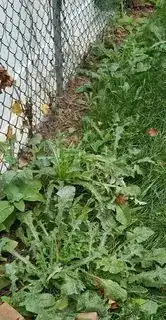In one of my past posts, I asked how to seed my 20 x 25 ft backyard. I had great results by following your recommendations. I also left 1 1/2 ft as a bare ground border, keeping it weeded by pulling anything that popped up. I want to use that for my organic gardening. This past summer I tilled in the grass clippings and vegetable peels from my kitchen.
I'm hoping that the ground will have time to decompose this over the winter, however, toward the end of spring I saw a number of big plants! The first one on the left now has purple berries on it. The one in the middle is a 4 foot giant that popped up out of the blue. It looks like a dandelion on steroids! The last one on the right looks like big crab weeds. Are they just that?
Any idea what these are? Can I eat them? Are they some kind of poison ivy? Can I just pull them and they'll be gone?
Click on pictures for full size view.


